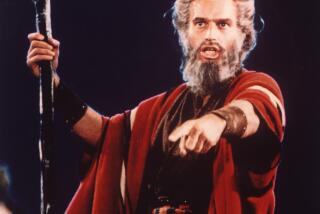For 25 Years, Public TV’s Been True to Its Name
- Share via
Take your pick. Do you and your family want to watch “Sesame Street,” “The Puzzle Place,” “The Frugal Gourmet,” “NOVA,” “Masterpiece Theatre,” “This Old House” and “Mystery” or sitcoms, sex-filled soap operas, tabloid talk shows and violent police dramas, intermixed with lots of advertising? Fortunately, you and I actually do have a choice.
The reason: public television. For more than 25 years, public television has been providing an alternative to commercial networks. It is both an educational and cultural resource, which has set the standard for high-quality programming.
The national debate over the future of public television has led some critics to claim that public television programming serves a limited audience and, despite receiving taxpayer dollars, conducts its affairs without community input (“The ‘Secret’ Life of Public TV,” Calendar, Feb. 20). Nothing could be further from the truth.
*
Public television offers viewers of all ages, genders, races and socioeconomic backgrounds an extremely accessible option of nonviolent, educational and inspirational programming without commercials. And, unlike cable, which costs a household an average of $300-$600 per year, public television is free to viewers.
Preschoolers, students K-12, college students, young adults, the middle-aged and seniors all benefit from public television.
Let’s take a look at KCET, Los Angeles’ No. 1 Public Broadcasting Service (PBS) station. Here are the facts:
* KCET’s broadcasting signal extends throughout Southern and Central California, from North San Diego County to San Luis Obispo and everywhere in between;
* In January, 1995, 75% of all households in KCET’s signal area tuned in to the station’s programming;
* Each year, more than 1.5 million K-12 students use KCET’s educational programming repeatedly in their schools;
* This year, more than 40,000 adults will earn college credit from KCET’s televised courses.
These facts certainly do not define a limited audience to me.
Moreover, to ensure it is both effective and responsive, the management of KCET operates the station as a business, making daily operating decisions, while keeping the doors open for community input through a number of formal and informal mechanisms.
For example, in 1979, KCET established its Community Advisory Board (CAB) to review the station’s goals, services and significant policy decisions, and make recommendations to the station’s management and Board of Directors on programming and other policies that address the special education and cultural needs of our communities.
CAB is a coalition of nearly 30 volunteers, to which I belong, who represent an array of community interests including ethnic, social, gender and economic diversity. We meet at least 10 times a year to ensure that KCET remains true to its mission: to educate and inspire by providing unique and valuable programs and services to diverse communities.
The station’s board of directors, which provides continuous input, also reflects Southern California’s diverse population. In addition, KCET receives thousands of telephone calls and letters each year from viewers and community members with applause, complaints and suggestions which are all taken very seriously.
*
Unlike most government programs, public television represents a public-private partnership that is cost-effective and beneficial. Federal funding constitutes 18% of the entire national public broadcasting budget, which radio and television stations in turn leverage four to five times in contributions from other private sources.
Public television teaches children values, self-respect and self-esteem, as well as how to count, spell and read; it helps adults broaden their education and entertains as well as challenges the minds of all viewers.
It’s free, accessible and, most of all, absolutely public.
More to Read
The complete guide to home viewing
Get Screen Gab for everything about the TV shows and streaming movies everyone’s talking about.
You may occasionally receive promotional content from the Los Angeles Times.






